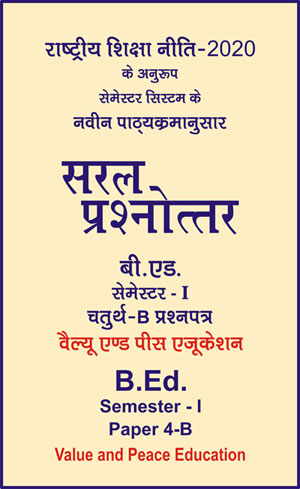|
बी एड - एम एड >> बी.एड. सेमेस्टर-1 प्रश्नपत्र-IV-B - वैल्यू एण्ड पीस एजुकेशन बी.एड. सेमेस्टर-1 प्रश्नपत्र-IV-B - वैल्यू एण्ड पीस एजुकेशनसरल प्रश्नोत्तर समूह
|
5 पाठक हैं |
||||||
बी.एड. सेमेस्टर-1 प्रश्नपत्र-IV-B - वैल्यू एण्ड पीस एजुकेशन (अंग्रेजी भाषा में)
Chapter 5 -Values Realization, Value Conflict and Value Crisis
Question- How to resolve a Value Conflict?
Answer -
A value conflict occurs when individuals or groups of people hold strong personal beliefs that are in disagreement within themselves or in disagreement with the institution’s/ organization’s values. These may include religious differences, cultural differences or differences in upbringing.
Values-based conflicts are particularly pervasive in public policy. Indeed, nearly all public (policy) controversies entail divergent beliefs about what is right and what is wrong, what is just and what is unjust. Many policy decisions are essentially choices among competing values. Simply consider how:
(i) Efforts to promote equal opportunity might result in conflicts among values such as efficiency, justice, equality, diversity, merit, and individual achievement;
(ii) Crime prevention policies might trigger competition among values such as liberty, safety, due process, equity, effectiveness, access, and justice; and
(iii) Domestic security policies might produce conflict among values such as knowledge generation, information sharing, confidentiality, privacy, civil liberties, individual rights, and safety.
Framework of Ethical Behaviour
The role of ethics in public life has many dimensions. At one end is the expression of high moral values and at the other, the specifics of action for which a public functionary can be held legally accountable. Any framework of ethical behaviour must include the following elements:
(i) Codifying ethical norms and practices.
(ii) Disclosing personal interest to avoid conflict between public interest and personal gain.
(iii) Creating a mechanism for enforcing the relevant codes.
(iv) Providing norms for qualifying and disqualifying a public functionary from office.
(v) Public Interest and Public Administration.
The public interest refers to the “common well-being” or “general welfare”. The public interest is central to policy debates, politics, democracy and the nature of government itself. Government has a universalistic character. It has to serve the common good without making any sort of distinction between man and man. The importance of a sense of public interest as a wider ethical commitment in public administration assumes significance in this context.
Formula for Resolving a Values Conflict
To resolve values conflicts, use the equation below. By understanding this equation, it will let us know exactly what to do when those scenarios present themselves.
A = H + / - B
The A stands for the brand new value that you want to add into your life. In this case, the person does not have a coaching business, so A will be a coaching business.
B equals the current value that they have in their life. In the first example, B would be the person’s family. So, A is the coaching business, and B is the person’s family.
Now, H stands for help or help me or helping. Then obviously, the +/- determines whether or not you want to have more or less of B.
Four Ways to Resolve a Conflict
There are four viable options to resolve any kind of conflict, including a values conflict:
-
Ignore it : Sometimes a conflict is so small, it’s almost irrelevant. Any attempt to address it is like making a mountain out of a molehill. In such cases, the best solution is to just ignore it. For example, a shipment arrives 20 minutes later than you promised, but no one seems concerned or makes any fuss about it. Just ignore it.
-
Address it : Oft times conflicts can be resolved by simply addressing them directly. In an organization, a values conflict might arise if decisions are made or actions taken that result in compromising a stated value. Having a meaningful and respectful discussion with others impacted may be the simplest way to resolve it. For example : sincerely apologizing for missing a promised delivery date, explaining the steps taken to fix the situation, and the plan to prevent it from happening again.
-
Negotiate around it : Sometimes a conflict is more complicated than we initially thought or involves more parties than originally considered. Ideally this is a healthy conflict where you’re just following the process to find the best solution to resolve a gnarly problem, even if the discussion with others is heated at times. What matters most is to stay focused on the problem, not the people involved. For example, the inclusion of a new product feature requested by customers requires sacrificing the long-standing values of simplicity and ease-of-use, that have differentiated the company for years. Should this particular customer request be ignored? Or is it time for the company to shift the priority of differentiating values? There are no easy answers here. It requires the involvement of all stakeholders. But working together, creative solutions can be uncovered that open up new possibilities.
-
Mediate through it : There are times a conflict turns out to be quite serious and requires more drastic action. Sometimes there are significant financial implications. Other times it may be bruised egos getting in the way (including our own). Resolving such conflict requires a strong mediator : to listen well, ask thoughtful questions, be able to influence others to compromise, and find the best solution that works for everyone. For example, poor quality output, missed deadlines, low morale, and unhappy customers are a clear indication there are bigger issues at stake. Someone external clearly needs to be brought in to identify the real issues and push for real change.
|
|||||













